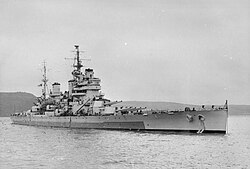HMS Anson (79)
|
The Anson 1945 in Devonport
|
||||||||||||||||||
|
||||||||||||||||||
|
||||||||||||||||||
|
||||||||||||||||||
|
||||||||||||||||||
The HMS Anson ( 79 ) was a British battleship of the King George V class , which during the Second World War was used.
It was named after Admiral George Anson, 1st Baron Anson . Originally the name Jellicoe - after John Jellicoe, 1st Earl Jellicoe , the commander of the Grand Fleet in the Battle of the Skagerrak - was intended for this ship. Before the ship was launched in February 1940, it was decided to christen the ship with the name Anson .
history
The ship was laid on July 20, 1937 at Swan, Hunter & Wigham Richardson in Newcastle upon Tyne . The launch took place on February 24, 1940, on June 22, 1942, the battleship was then put into service with the Royal Navy in Newcastle.
From September 1942 to January 1943, the Anson took over the security of the northern convoys in the Arctic Ocean going to the Soviet Union . On October 4, 1943, it was part of the remote security of the rangers during their attacks on Bodø . From November 1943 to March 1944 the ship again secured the North Sea convoys against enemy attacks, in April 1944 the Anson was part of the security group for the aircraft carriers Furious and Victorious when they attacked the German battleship Tirpitz .
From June 1944 to March 1945, the Anson was overhauled and modernized in Devonport . On April 25, 1945, the ship then left Scapa Flow in the direction of the Mediterranean, crossed the Suez Canal and arrived in Sydney in July 1945 , where the Anson became the flagship of the 1st Battle Squadron (1st battle squadron) of the British Eastern Fleet in the Indian Ocean . It began with preparations for the support of amphibious landing operations in mainland Japan, after the surrender of Japan these were stopped. At the end of August 1945, the battleship entered Hong Kong . In January and February 1946 the Anson was overtaken in Sydney, on June 21, 1946 she sailed for England, where she arrived in Portsmouth on July 29 . There it was overhauled again by October 1946, after which it was reintegrated into the British Home Fleet.
Another overhaul took place in Devonport in 1947, and from 1949 the Anson was part of the Home Fleet Training Squadron. From November 1949 to August 1950, the ship was modernized again and then transferred to the reserve fleet. In November 1951 the decommissioning took place, until it was deleted from the ship's registers on April 30, 1957, the Anson remained in reserve. On December 17, 1957, the former battleship was sold to Shipbreaking Industries in Faslane for scrapping and demolished until 1959.
The Anson served in World War II, but she was the only ship in her class that had no battle with the enemy.
literature
- William Garzke, Robert Dulin: British, Soviet, French, and Dutch Battleships of World War II , 1980, Jane's, ISBN 9780710600783 (English)
Web links
- HMS ANSON - King George V-class 14in gun battleship . Mission history at naval-history.net (English)
- HMS Anson Photo Gallery , MaritimeQuest
